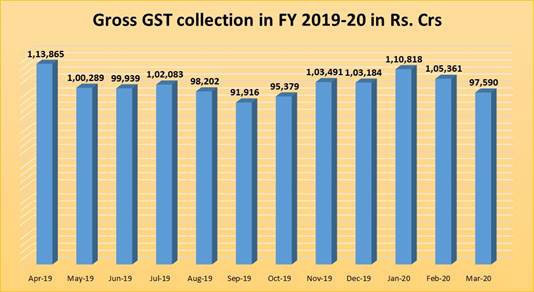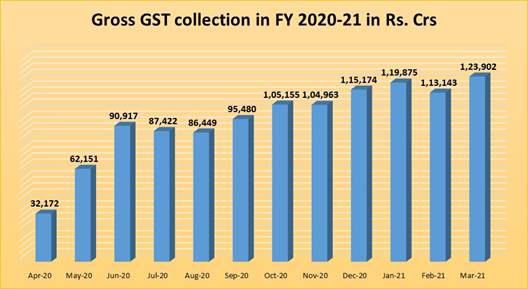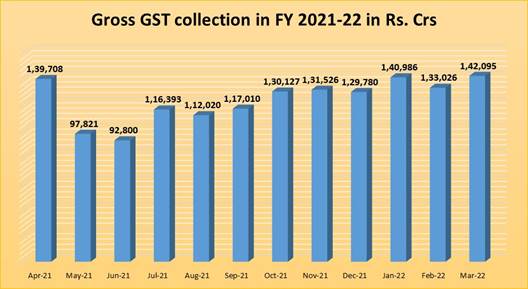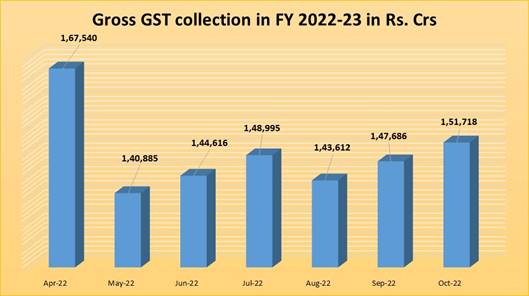Others
One Nation-One Tax Goods and Services Tax
प्रविष्टि तिथि:
01 JUL 2022 19:27 PM
One Nation-One Tax
Goods and Services Tax
(Ministry of Finance)
July 01, 2022
(Updated on November 02, 2022)
1. Introduction
In the words of Prime Minister Narendra Modi, the Goods and Services Tax (GST) is “a path-breaking legislation for New India”. This revolutionary taxation system was rolled out on the midnight of 1 July, 2017 in a ceremony held in the Central Hall of Parliament. GST is not merely a tax reform but a milestone in realizing Sardar Vallabhbhai Patel’s dream of building ‘Ek Bharat – Sreshtha Bharat’.
2. Need for GST
- Before 1 July 2017, Indian indirect tax regime was highly fragmented. Centre and States were separately taxing goods and services. There were many taxes like excise duty, service tax, VAT, CST, purchase tax, entertainment tax etc.
- In addition, there was multiplicity of rates, laws and procedures. This caused heavy compliance burden.
- Imposition of tax on tax was another serious problem. For example, VAT was levied on a value that included excise duty.
- Input tax credit chain broke as goods moved from one state to another, resulting in hidden cost for the business.
- There were tax nakas at every inter-state border, creating bottlenecks in inter-state transport of goods.
- Every state was effectively a distinct market for the industry as well as consumer.
- Industry’s choice of locating factories or warehouses was heavily influenced by the prevailing tax regime rather than pure business consideration, making the industry uncompetitive.
3. The Journey to GST – Timeline
- 2000 – PM conceptualized GST and setup a committee to design GST model
- 2003-04 – FRBM Committee formed which recommended introduction of GST
- 2006 – Union Finance Minister, in the 2006-07 Budget Speech, announced introduction of GST from April 1, 2010.
- 2009 – First discussion paper on GST released
- 2011 – Constitution (115th Amendment) Bill 2011 for incorporating relevant provisions of GST introduced in Parliament
- 2011-13 – GST Bill referred to Standing Committee
- 2014 – Constitution (115th Amendment) Bill lapsed with the dissolution of 15th Lok Sabha, necessitating a fresh Constitutional Amendment Bill
- 2014-15 – The Constitution (122nd Amendment) (GST) Bill, 2014 was introduced and passed in May 2015
- August 2016 – The Constitution (101st Amendment) Act was enacted
- September 2016 – Constitutional changes made vide 101st Amendment come into force. GST Council created, 1st GST Council Meeting held
- May 2017 – GST Council recommended all the rules
- 1st July 2017 – GST Launched
- Post 2014, the Central Government expedited the process, resumed discussions with states and all other stake holders with new vigour.
- Two significant initiatives of the Government of India – creation of the GST Council and assuring the States of a guaranteed revenue flow to them proved to be decisive in bringing the States on board.
- Government of India assuring each State a minimum growth of 14 per cent per year for five years over their revenues. This commitment of Centre clearly showed its belief in the long-term benefits of GST and helped assuage the concerns of the States.
- Creation of Goods and Service Tax Network (or GSTN), a special purpose vehicle, by the Central Government, for automation of business processes with equal participation of Centre and States, with its adequate resourcing was also a major step taken by central Government towards GST.
4. Salient Features of GST
- Ending decades of twists and turns, GST subsumed 17 large taxes and 13 cesses
- With uniform tax on supplies of goods and services, India turned into one market.
- GST ensured compliance simplification with:
- Uniform processes across the country
- Simple registration process - Single return - Minimal physical interface
- Faster refunds
- Fully IT driven system
- Free flow of goods – Check posts removed
5. Benefits of GST to MSME
- MSMEs have gained significantly by GST.
- Earlier VAT exemption and composition scheme thresholds were very small.
- In GST, threshold has been initially fixed at Rs 20 lakh and has subsequently been increased to Rs 40 lakh for goods.
- GST introduced a composition scheme which allowed small businesses to pay a fixed rate on their turnover without any paperwork. This composition threshold is Rs 1.5 crore a year for goods and Rs 50 lakh for services.
- GST has opened up new avenues through quick bill discounting and loans to MSMEs.
- Compliance burden of MSMEs has reduced significantly with option of quarterly return filing for taxpayer having annual turnover of Rs 5 crore.
6. Benefits of GST to Consumers
- GST is a pro-people reform. Hence, consumer is at the centre of this reform.
- Average tax rates in GST have come down. This has been made possible as tax base expanded on rollout of GST and compliance improved. Taxpayers’ number has doubled from earlier 60 lakh to about 1.2 crore.
- The Government has progressively lowered tax rates on essential and daily use items.
- A Finance Ministry study suggested that consumers saved at least four per cent on their household monthly expenses on an aggregate after GST.
- Thus, consumers now spend less on daily consumables like cereals, edible oils, sugar, sweets and snacks.
7. Impact of GST on Logistics Sector
- GST ended long queues of trucks & goods carriers at highway toll plazas freeing goods movement across states.
- Nakas, notorious for corruption and also resulting in restricting and slowing down the movement of goods disappeared.
- Credible studies point to an improvement of over 33 per cent in transport time after GST implementation.
- Millions of litres in petrol and diesel have also been saved apart from decongesting arterial roads.
- E-way bill system has helped government to facilitate monitoring of movement of essential commodities and medical supplies during lockdown necessitated by Covid-19 pandemic.
8. GST and Cooperative Federalism
- GST is the finest example of co-operative federalism in the history of India.
- Centre and States overcame all the hurdles in the way of GST, in complete consensus, in the larger interest of the country and its people.
- The GST Council, a federal body comprising the Union Finance Minister as its Chairman and Finance Ministers of all States as members, has played its role to perfection.
- Tax administration of Centre and States are working in close harmony.
- One of the biggest triumphs associated with GST is the spirit and display of cooperative federalism, with almost all decisions on GST being taken with consensus among members of the GST Council.
9. Outcome of New Tax Regime
- Tax base has doubled in GST.
- Goods now move faster.
- Refunds come quickly.
- Consumer gains with reduction tax burden on items of consumption.
10. GST collection Month on Month for the last four years.
- The gross GST collection in April 2022 is all time high at Rs. 1.67 lakh crore.
- October 2022 GST collection has been the second highest at over Rs. 1.51 lakh crore.
- The revenues for the month of June 2022 are 56% higher than the GST revenues in the same month in 2021 of ₹92,800 crore.
- The average monthly gross GST collection for the first quarter of the FY 2022-23 has been ₹1.51 lakh crore against the average monthly collection of ₹1.10 lakh crore in the first quarter of the last financial year showing an increase of 37%.





Source:
AG/HP/RC/PPD/PB/SS
RU-14-02-0028-010422/FACTSHEET
(तथ्य सामग्री आईडी: 148644)
आगंतुक पटल : 8154
Provide suggestions / comments